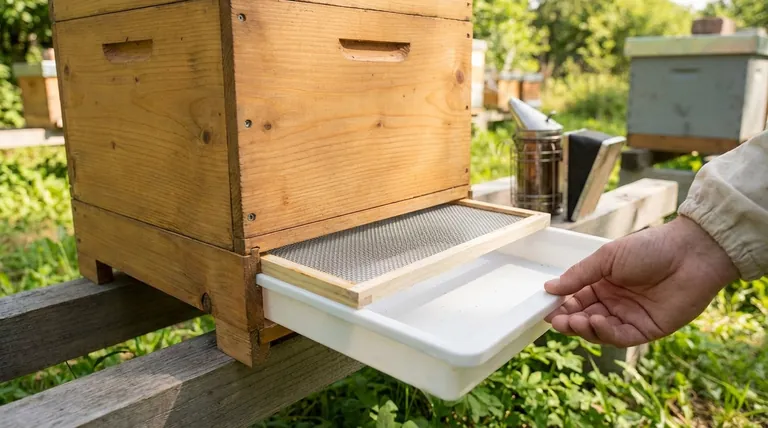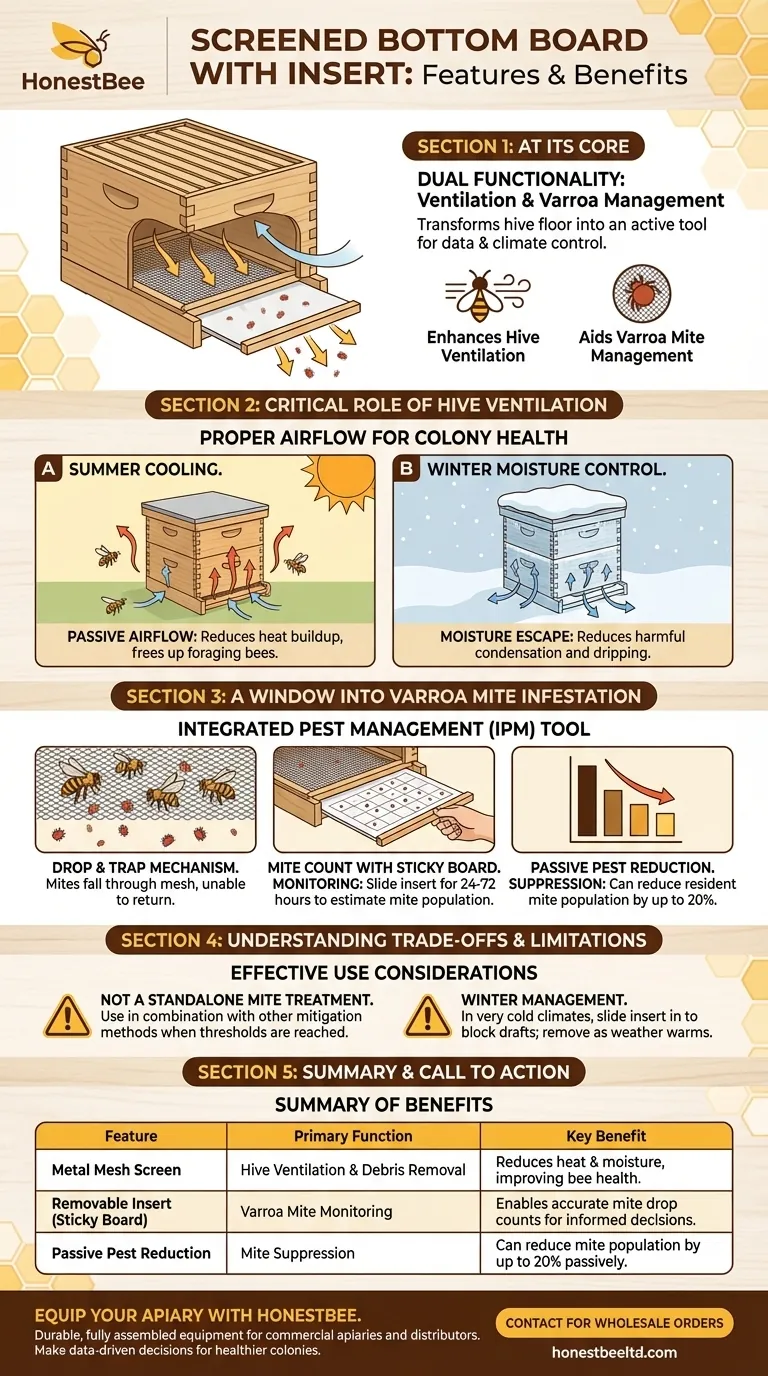At its core, a screened bottom board is a hive floor replacement that serves two primary functions: enhancing hive ventilation and aiding in Varroa mite management. This fully assembled component features a durable metal mesh screen that allows mites and debris to fall out of the hive. It includes a removable insert, often called a "sticky board," which is essential for monitoring pest levels.
The true value of a screened bottom board is that it transforms the hive floor from a passive component into an active management tool. It provides crucial data on pest pressure and gives you greater control over the hive's internal climate, directly impacting bee health.

The Critical Role of Hive Ventilation
Proper airflow is non-negotiable for a healthy colony. A screened bottom board provides superior ventilation compared to a solid wood bottom, offering distinct advantages in both summer and winter.
Summer Cooling
In hot climates, a colony can expend significant energy fanning the hive to regulate its internal temperature. The screen allows for passive airflow, reducing heat buildup and freeing up foraging bees from climate control duties.
Winter Moisture Control
During winter, the bees' respiration creates warm, moist air. When this air hits a cold inner cover, it condenses and can drip back down onto the cluster, chilling or killing the bees. A screened bottom allows this moist air to escape, dramatically reducing harmful condensation.
A Window into Varroa Mite Infestation
The Varroa destructor mite is one of the greatest threats to honey bee colonies. A screened bottom board is a foundational tool in an Integrated Pest Management (IPM) strategy.
The "Drop and Trap" Mechanism
As bees groom themselves or move around the hive, Varroa mites can become dislodged. With a screened bottom, these mites fall through the mesh and out of the hive, unable to climb back up and re-infest another bee.
Using the Sticky Board for Mite Counts
The included insert (sticky board) is the key to monitoring. By sliding it beneath the screen for a set period (typically 24-72 hours), you can perform a "mite drop count." This gives you a reliable estimate of the mite population within the hive, allowing you to determine if and when treatment is necessary.
Aiding in Passive Pest Reduction
Studies and observations suggest that a screened bottom board alone can reduce the resident mite population by up to 20%. This passive reduction is a helpful supplement to more active treatments.
Understanding the Trade-offs and Limitations
While highly beneficial, this equipment is not a silver bullet. Understanding its limitations is key to using it effectively.
Not a Standalone Mite Treatment
A screened bottom board is a monitoring and suppression tool, not a complete mite treatment. Relying on it alone is an ineffective strategy. It must be used in combination with other mitigation methods when mite counts reach established treatment thresholds.
Winter Management Considerations
In very cold climates, the constant airflow can create a draft that forces the winter cluster to consume more honey to stay warm. Most beekeepers slide the insert in during the coldest parts of winter to block the screen and reduce this draft, removing it again as the weather warms.
Making the Right Choice for Your Apiary
Deciding to use a screened bottom board depends on your management goals and local climate.
- If your primary focus is proactive pest management: This is an essential diagnostic tool that helps you know precisely when your colony needs treatment for mites.
- If you keep bees in a hot or humid climate: The superior ventilation is a significant advantage for reducing colony stress and improving productivity.
- If you are a new beekeeper seeking to understand your hives: It provides simple, easy-to-gather data on colony health and cleanliness.
Ultimately, this equipment empowers you to make data-driven decisions for a healthier, more resilient colony.
Summary Table:
| Feature | Primary Function | Key Benefit |
|---|---|---|
| Metal Mesh Screen | Hive Ventilation & Debris Removal | Reduces heat and moisture, improving bee health. |
| Removable Insert (Sticky Board) | Varroa Mite Monitoring | Enables accurate mite drop counts for informed treatment decisions. |
| Passive Pest Reduction | Mite Suppression | Can reduce mite population by up to 20% passively. |
Equip your apiary with the right tools for success. HONESTBEE supplies durable, fully assembled screened bottom boards and other essential beekeeping equipment to commercial apiaries and distributors through our wholesale-focused operations. Make data-driven decisions for healthier, more productive colonies. Contact HONESTBEE today to discuss your needs and place your wholesale order.
Visual Guide

Related Products
- Australian Pine Wood Langstroth Screen Bottom Board for Wholesale
- Langstroth Screen Bottom Board for Beekeeping Wholesale
- HONESTBEE Wooden Bee Escape Board with Triangle Mesh Design for Beekeeping
- Professional Galvanized Hive Strap with Secure Locking Buckle for Beekeeping
- Boardman Entrance Bee Feeder Durable Galvanized Steel and Wood Construction for Beekeeping
People Also Ask
- Are screened bottom boards necessary for beekeeping? A Strategic Choice for Modern Hive Health
- What are the assembly options for the Cypress Screened Bottom Board? Ready-to-Use for Immediate Hive Health
- How should the screened bottom board be used throughout the year? A Guide for Healthy Hives
- What are the pros and cons of a screened bottom board? Optimize Hive Health for Your Climate
- What are the steps to install wire mesh as a floor in a beehive? A Guide to Better Ventilation & Mite Control



















